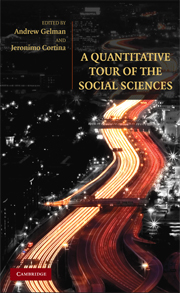Book contents
- Frontmatter
- Contents
- Preface: Learning to Think Like a Social Scientist
- About the Contributors
- PART I MODELS AND METHODS IN THE SOCIAL SCIENCES
- PART II HISTORY
- PART III ECONOMICS
- 8 Learning from Economic Data
- 9 Econometric Forecasting and the Flow of Information
- 10 Two Studies of Interest Rates and Monetary Policy
- PART IV SOCIOLOGY
- PART V POLITICAL SCIENCE
- PART VI PSYCHOLOGY
- PART VII TO TREAT OR NOT TO TREAT: CAUSAL INFERENCE IN THE SOCIAL SCIENCES
- References
- Index
9 - Econometric Forecasting and the Flow of Information
Published online by Cambridge University Press: 05 June 2012
- Frontmatter
- Contents
- Preface: Learning to Think Like a Social Scientist
- About the Contributors
- PART I MODELS AND METHODS IN THE SOCIAL SCIENCES
- PART II HISTORY
- PART III ECONOMICS
- 8 Learning from Economic Data
- 9 Econometric Forecasting and the Flow of Information
- 10 Two Studies of Interest Rates and Monetary Policy
- PART IV SOCIOLOGY
- PART V POLITICAL SCIENCE
- PART VI PSYCHOLOGY
- PART VII TO TREAT OR NOT TO TREAT: CAUSAL INFERENCE IN THE SOCIAL SCIENCES
- References
- Index
Summary
Before considering examples, let me introduce some background material on statistical models for economic time series. The level of a series today is equal to the level of the series plus some independent draw from a distribution, and, if the series is a random walk, it can also be rewritten as saying equivalently that the level of the series today is just a simple sum of all past disturbances or increments to the series. For a random walk, the series is just the sum of random variables that themselves are an independent draw from the same distribution. We saw in the previous chapter that this same basic idea can also be applied to a series with more general and elaborate temporal dependence, but the idea throughout is that the series, even if that series itself exhibits this dependence, is the sum of variables that do not. It is the ability to write it that way that enables us to make inferences and to estimate things that we need to estimate.
We write the random walk this way, saying that the expected product of these random variables is εt and that εt−j is 0. This means that these residuals or disturbances are unrelated to the history of the series, but they certainly are not unrelated to the future. In particular, it is not the case that the expectation of the disturbance today and the realization of the series in i periods in the future is equal to zero.
- Type
- Chapter
- Information
- A Quantitative Tour of the Social Sciences , pp. 111 - 133Publisher: Cambridge University PressPrint publication year: 2009



